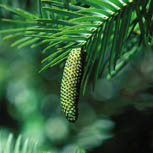The Wollemi Pine compiled by Si Mi Au
瓦勒邁杉(Wollemi Pine ) 在十年前於澳洲被人發現前,一直被認為是絕種的植物,據信兩億年前的侏羅紀時期就已存在。蘇富比拍賣公司24日表示,世界各地的買家為了取得此一稀有品種的樹木,已累計付出將近八十萬美元的代價。 科學家原本以為瓦勒邁杉在兩百萬年前絕種,不過到了一九九四年時,有人在雪梨以西的山谷發現長了十五株這種樹木。於是,取自這些樹叢的插枝就被用來培育二百九十二株的瓦勒邁杉,並於23日進行首次拍賣。恐龙时代松树外表吸引,顽强的生命力甚至在低光线的环境下依然保持生长,是理想的室内装饰植物,令公园花园更添生色。尤其作为像圣诞节或农历新年等重要节日的高尚送礼首选。 除作为室内摆设之外,恐龙时代松树也可适应在0~40摄氏度的环境下生长,其适应能力非常高,是新千年的理想装饰植物。 One of the world's oldest and rarest tree species belonging to a 200 million-year-old plant family... It was known from fossil records and presumed extinct until it was discovered in 1994 by a bushwalker in the Wollemi National Park only 200 km from Sydney, Australia’s biggest city.. Dubbed the botanical find of the century, the Wollemi Pine is now the focus of extensive research to conserve this ancient species. A majestic conifer with attractive, unusual dark green foliage and bubbly bark, the Wollemi Pine can grows up to 40 metres high in the wild with a trunk diameter of over one metre. It has unusual pendulous foliage with light apple green new tips in spring and early summer contrasting against the older dark green foliage. Another unique feature is its pattern of branching with the mature foliage having two ranks of leaves along the branches. Its bark is also distinct even from related species, looking very much like bubbling chocolate. The Wollemi Pine's closest living relatives are the Norfolk Island Pine, Bunya Pine, Hoop Pine, Monkey Puzzle Pine and Kauri Pine.
distinctive park
mature foliage The Wollemi Pine is named after the Wollemi National Park, the location where the Pines were first discovered in Sydney's now World Heritage-listed Blue Mountains. Wollemi is an Aboriginal word meaning "look around you, keep your eyes open and watch out". The scientific name Wollemia nobilis is a reflection of the Pine's majestic qualities and honours David Noble who found the first trees in 1994. The Wollemi Pine was discovered as a small grove of seedlings and mature trees only 200 kilometres west of Sydney (Australia) in the Wollemi National Park. Since then, two other small groves have been discovered. The Pines are growing on moist ledges in a deep rainforest gorge surrounded by rugged mountains and undisturbed forest. The exact location of the Pines is a closely kept secret because of the pristine and fragile nature of the wild habitat. Only select researchers are permitted to visit the area on rare occasions.
The Pines have grown in temperatures from -5 to 45°C (23 to 113°F) and trials in the USA and Japan have indicated that it will survive temperatures as cold as -12°C (5 °F). They are fast growing, respond well to light and favour acid soils. The Wollemi Pines produced from seeds and cuttings from the wild population are growing rapidly and averaging about half a metre in height a year.
Unique Characteristics Sex Propagation As seeds from the wild population are difficult and dangerous to collect, and collection poses the threat of damage to the trees, propagation is being carried out vegetatively from young plants grown from the original seeds and cuttings from the Wollemi Pines in the wild. Research is also being conducted to test the viability of utilising micro propagation methods for commercial production. Wollemi Australia has been exclusively licensed by the Royal Botanic Gardens Sydney (RBGS) through NSW National Parks and Wildlife Service (NPWS) to propagate and market the Wollemi Pine in Australia and internationally. This agreement ensures that royalties are returned to fund the conservation of the Wollemi Pine in the wild and other endangered species. All Wollemi Pines grown and marketed by Wollemi Australia will be identified by their authentication certificates, labelling and packaging bearing the registered Wollemi Pine logo. The Wollemi Pine logo will be recognisable as the official branding of the product that returns royalties to conservation. The National Geographic Society announced it will sell the Wollemi Pine, one of the world's oldest and rarest trees, to consumers in the United States this holiday season. Fewer than 100 tree exist in the wild. National Geographic sees the sales as an opportunity to conserve and propagate the species, which was believed to be extinct until a small grove of trees was discovered in Australia's Blue Mountains in 1994. The tree is believed to have existed since the time of dinosaurs. A portion of the proceeds from sales of the $99.95 tree will go towards conservation efforts of the species. National Geographic says the species is "easy to grow either an indoor plant or a garden plant in partial shade or full sun" and is "capable of surviving a broad range of temperatures, from 23 degrees F to 113 degrees F."
|




